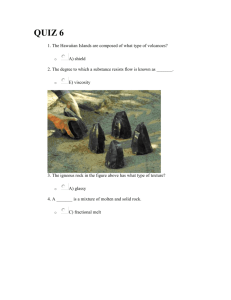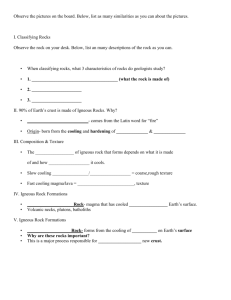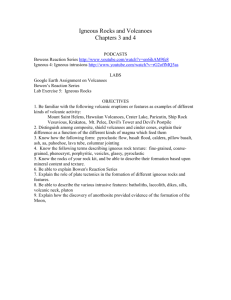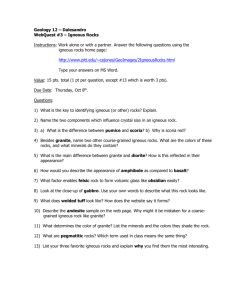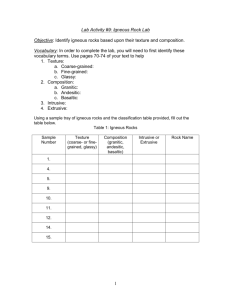Regents Earth Science Igneous Rock ID Lab Mr. Williams Geology
advertisement
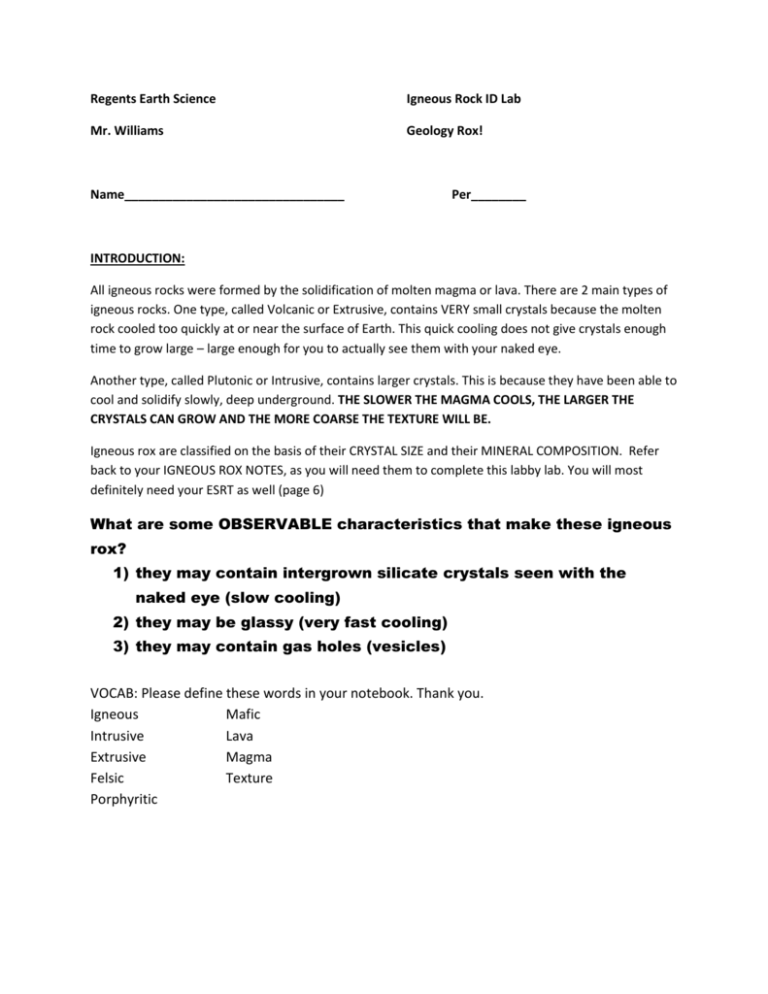
Regents Earth Science Igneous Rock ID Lab Mr. Williams Geology Rox! Name________________________________ Per________ INTRODUCTION: All igneous rocks were formed by the solidification of molten magma or lava. There are 2 main types of igneous rocks. One type, called Volcanic or Extrusive, contains VERY small crystals because the molten rock cooled too quickly at or near the surface of Earth. This quick cooling does not give crystals enough time to grow large – large enough for you to actually see them with your naked eye. Another type, called Plutonic or Intrusive, contains larger crystals. This is because they have been able to cool and solidify slowly, deep underground. THE SLOWER THE MAGMA COOLS, THE LARGER THE CRYSTALS CAN GROW AND THE MORE COARSE THE TEXTURE WILL BE. Igneous rox are classified on the basis of their CRYSTAL SIZE and their MINERAL COMPOSITION. Refer back to your IGNEOUS ROX NOTES, as you will need them to complete this labby lab. You will most definitely need your ESRT as well (page 6) What are some OBSERVABLE characteristics that make these igneous rox? 1) they may contain intergrown silicate crystals seen with the naked eye (slow cooling) 2) they may be glassy (very fast cooling) 3) they may contain gas holes (vesicles) VOCAB: Please define these words in your notebook. Thank you. Igneous Mafic Intrusive Lava Extrusive Magma Felsic Texture Porphyritic PROCEDURE: You are going to identify igneous rocks based on their: 1) Color – Light or Dark 2) Texture – Coarse, Fine, Glassy, Vesicular 3) Minerals that are possibly present in the rox PLEASE REFER TO YOUR IGNEOUS ROX NOTES AND YOUR HANDY DANDY ESRT – THEY WILL LEAD YOU TO YOUR IGNEOUS ROX INFORMATION STARDOM! Once you complete the rock ID, answer the following questions regarding igneous rox. Enjoy, and may the force be with you!! 1) What name is applied to a coarse-grained, felsic igneous rock? _________________________ 2) What rock has the same composition as granite, but smaller crystals?______________________ 3) Name a coarse grained, dark colored igneous rock. ______________________________ 4) What feature of pumice and scoria make them vesicular? ______________________________________________________________________________ ______________________________________________________________________________ 5) What 2 rock types are neither felsic nor mafic? (These 2 rocks have an intermediate composition and color)._______________________________ and __________________________________ 6) How do the 2 kinds of rock in question 5 differ from one another? ______________________________________________________________________________ __________________________________________________________ 7) With respect to Earth’s surface, where do extrusive rocks cool and crystallize (that is, where do they solidify)? ______________________________________________________________________________ ___________________________________________ 8) What is the texture of the very finest grained igneous rocks called?________________________ 9) What do gabbro and basalt have in common? ______________________________________________________________________________ ___________________________________________________________ 10) How can you tell that gabbro crystallized deeper underground than basalt did? ______________________________________________________________________________ ______________________________________________________________ WHEW! Well done. Now, please read the passage on the next page and answer the questions that follow. We already learned this, so it shouldn’t be a problem. Now go to it. IGNEOUS ROX ID CHART Sample Number Color(Light or Dark) Grain Size/Texture (coarse, fine, glassy, vesicular) 1 2 3 4 5 6 7 8 9 Minerals Possibly Present in Rock (use your ESRT!) Rock Name 10 11 12 USE THE LOWER PORTION (the minerals part) OF YOUR ESRT TO ANSWER THESE QUESTIONS!! 11) What minerals are usually found in granite? _______________________________________________________________ 12) What is the percentage of plagioclase in a typical granite? _______________ 13) a) List the 4 minerals usually found in basalt and then b) write the percentages of each. MINERAL NAME PERCENTAGE (%) 1 2 3 4 14) What 2 minerals tend to be found in the greatest range of igneous rocks? That is…which ones are the most common? ____________________________ and __________________________ 15) What igneous rock is generally composed of just 1 mineral? _________________________ 16) Unlike some other rocks, igneous rocks such as granite and gabbro are NEVER composed of rounded rock “fragments”. What are igneous rocks composed of? ______________________________________________________________________________ _______________________________________________________________ 17) Do igneous rocks usually have a layered texture? YES or NO (circle one) 18) What coarse grained igneous rock is similar in composition to basalt? _____________________ 19) What is the difference between granite and rhyolite? ______________________________________________________________________________ _____________________________________________________________ 20) Unlike other kinds of rocks, igneous rocks form from what substance? ______________________________________________________________________________ ________________________________________________________




